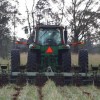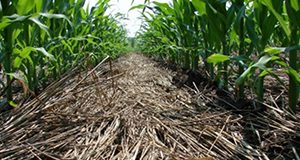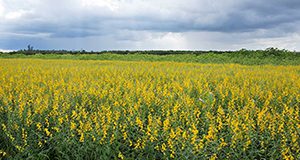When utilizing cover crops for weed suppression, one important consideration is effective termination before planting the main crop. A major issue with improper termination is that the cover crop can become problematic and compete with the main crop, like other weeds. However, proper planning of the termination timing and method can minimize these issues and maximize the benefits of cover crop use. This 5-page publication discusses herbicide application, roller-crimper termination, tillage, and appropriate growth stages for termination. Written by Pratap Devkota, Michael J. Mulvaney, and David Wright, and published by the UF/IFAS Agronomy Department, February 2021.
https://edis.ifas.ufl.edu/ag449
Tag: Cover Crops
Questions and Answers for Using Sunn Hemp (Crotalaria juncea L.) as a Green Manure Cover Crop
This 4-page document synthesizes information about the warm-season cover crop, sunn hemp. It addresses frequently asked questions for growers and summarizes the expanding body of sunn hemp research. The information is provided so growers in Florida can learn about up-to-date cultivation and management options as well as better understand sunn hemp’s practical uses. Written by Thioro Fall, Ariel Freidenreich, Stacy Swartz, Christopher Vincent, Yuncong Li, and Zachary Brym, and published by the UF/IFAS Agronomy Department, July 2020.
https://edis.ifas.ufl.edu/ag443
Agricultural Management Options for Climate Variability and Change: High-Residue Cover Crops (AE488)
 While decision making in agriculture involves many aspects beyond climate, including economics, social factors, and policy considerations, climate-related risks are a primary source of yield and income variability. This 4-page fact sheet focuses on the use of high-biomass winter cover crops to improve production systems. Written by Joel Love, Jed Dillard, Kirk Brock, Daniel Dourte, and Clyde Fraisse, and published by the UF Department of Agricultural and Biological Engineering, August 2012.
While decision making in agriculture involves many aspects beyond climate, including economics, social factors, and policy considerations, climate-related risks are a primary source of yield and income variability. This 4-page fact sheet focuses on the use of high-biomass winter cover crops to improve production systems. Written by Joel Love, Jed Dillard, Kirk Brock, Daniel Dourte, and Clyde Fraisse, and published by the UF Department of Agricultural and Biological Engineering, August 2012.
http://edis.ifas.ufl.edu/ae488
Cover Crops for Managing Root-Knot Nematodes (ENY063/IN892)

Root-knot nematodes are widespread and are pests of almost all major crops. Damage can be seen as galls or knot-like swellings produced along plant roots. Cover crops are used to manage nematodes because these microscopic roundworms can move only very short distances on their own and will starve without suitable host plants. This 6-page fact sheet describes several common cover crops that can be used for nematode management. Written by Harsimran K. Gill and Robert McSorley , and published by the UF Department of Entomology and Nematology, July 2011.
http://edis.ifas.ufl.edu/in892
HS387/HS387 Annual Cover Crops in Florida Vegetable Systems Part 1. Objectives: Why grow cover crops?
HS387, an 18-page illustrated fact sheet by Danielle Treadwell, Waldemar Klassen and Michael Alligood, is part one of a three-part series. This publication discusses the reasons why a producer might consider including a cover crop in the vegetable cropping system. Includes references. Published by the UF Department of Horticultural Sciences, February 2008.
http://edis.ifas.ufl.edu/HS387

